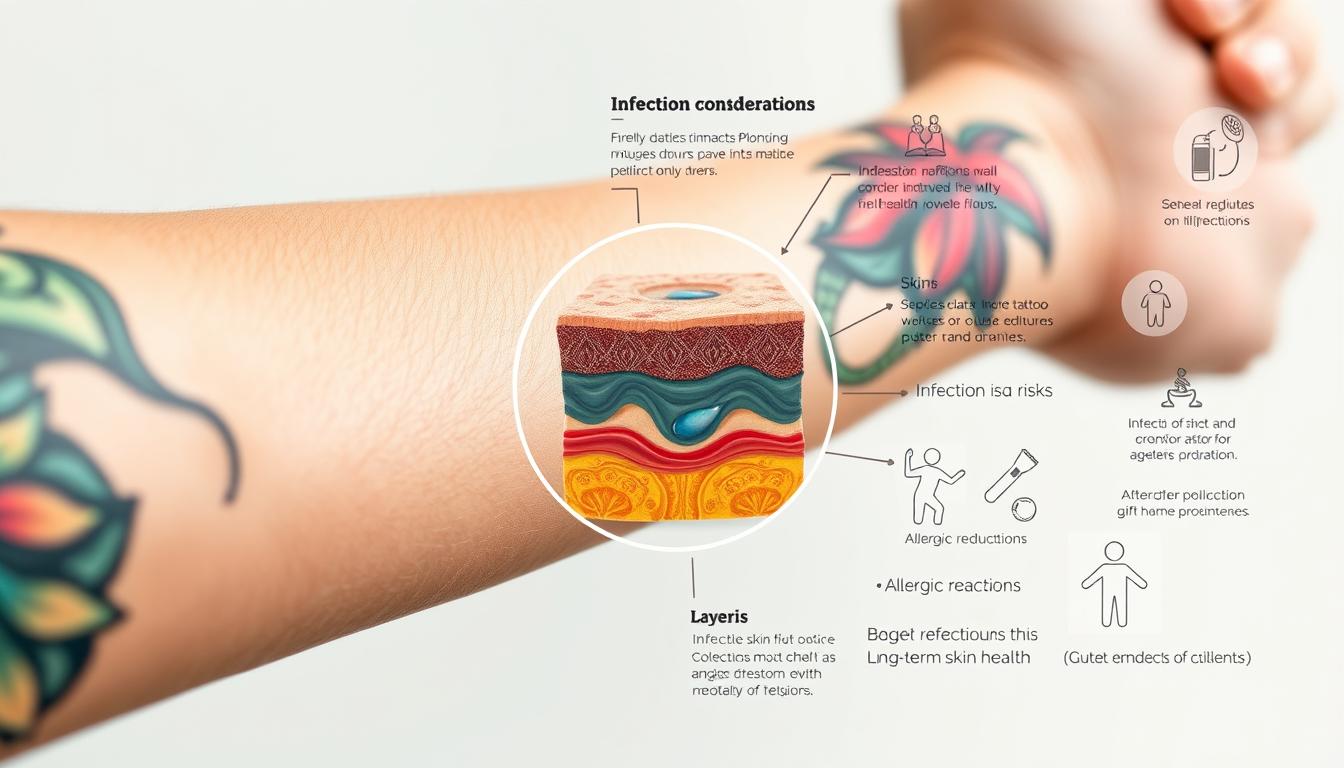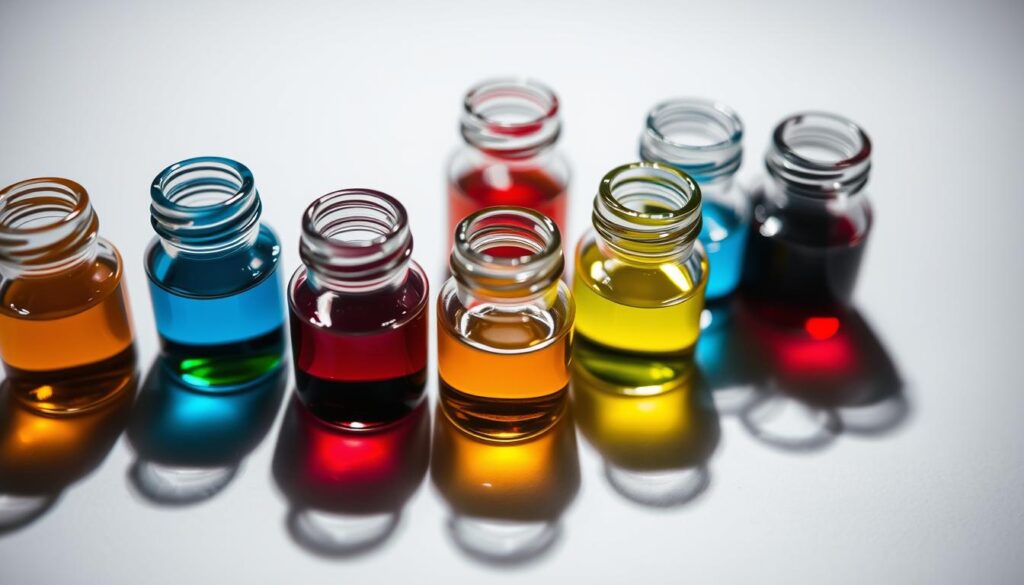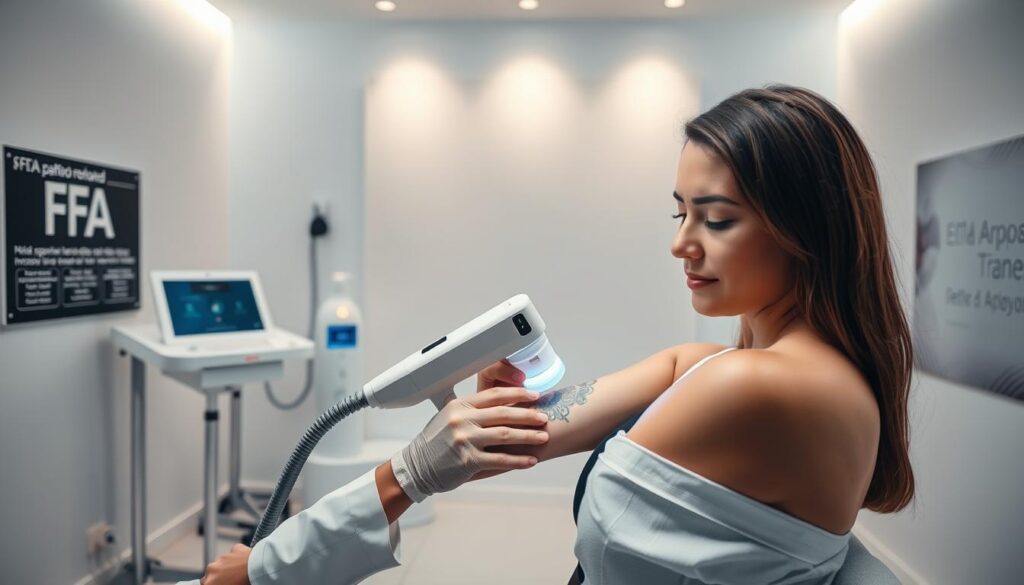
Imagine this: over 30% of adults in the United States now wear permanent ink on their skin. But what if the very designs celebrating your individuality carried unexpected consequences? While body art has surged in popularity, scientific understanding lags behind cultural acceptance.
Recent surveys reveal 22% of Americans sport multiple pieces. Yet here’s the twist: no federal agency fully regulates what goes into your skin. The FDA monitors ink safety but doesn’t approve specific pigments for cosmetic use. This gap leaves millions navigating uncharted territory with every needle stroke.
Potential issues range from allergic reactions to long-term immune responses. While most procedures go smoothly, some pigments might interact differently with various skin types. Research remains ongoing, making informed choices crucial before committing to permanent modifications.
Key Takeaways
- Nearly one-third of U.S. adults now have at least one piece of body art
- Regulatory oversight of ink ingredients differs from standard cosmetics
- Long-term biological impacts require more comprehensive studies
- Proper aftercare significantly reduces short-term complications
- Personal health history should guide decisions about modifications
Exploring Tattoo Health Risks

Choosing where to get inked might impact your health more than you realize. Research shows 35% of people using unregulated studios report complications versus 16% at professional shops. These health risks fall into two categories: temporary irritations and lasting medical concerns.
Overview of Medical Complications
Most people experience mild side effects like itching or swelling. These usually fade within weeks with proper care. But 1 in 10 develop advanced issues requiring doctor visits. Red ink causes 40% of delayed allergic reactions, sometimes appearing years later.
| Complication Type | Professional Studios | Unauthorized Facilities |
|---|---|---|
| Mild Reactions | 22% | 31% |
| Advanced Issues | 15.9% | 35.3% |
| Infections | 4% | 17% |
Insights from Recent Studies
Needles create micro-injuries where bacteria can enter. A 2023 Johns Hopkins review found improper aftercare doubles infection risks. Some pigments trigger immune responses – 68% of chronic reactions link to colored inks containing nickel or mercury.
Your best defense? Pick licensed artists using sterile tools. Watch for unusual redness or heat around new ink. Quick action prevents 89% of minor issues from becoming major problems.
Understanding Tattoo Inks and Their Ingredients

The colorful designs adorning your skin might hold secrets you’ve never considered. What gets permanently embedded beneath your epidermis often contains substances you wouldn’t expect in body art.
“Although color additives are approved for cosmetics, none get FDA clearance for skin injection,”
explains the Food and Drug Administration. This regulatory gray area leaves many wondering what exactly they’re putting in their bodies.
Common Pigments and Their Properties
Modern tattoo inks mix surprising components. Shellac resin binds pigments, while preservatives prevent bacterial growth. Colored varieties often use industrial-grade metals – nickel gives yellows their brightness, chromium stabilizes greens. A 2021 analysis of 70 inks revealed heavy metals in 89% of samples. Check this breakdown:
| Substance | Found In | Potential Effects |
|---|---|---|
| Nickel | 62% of inks | Allergic reactions |
| Chromium | 41% of inks | Skin irritation |
| Lead | 1 sample | Neurological risks |
Regulations and Safety Standards
No federal agency specifically approves what goes into tattoo inks. While the Food and Drug Administration monitors cosmetics, injected pigments operate in a regulatory gap. European studies found 93% of inks had incorrect labels – bottles listed “organic” but contained metals. Without strict oversight, manufacturers aren’t required to disclose all ingredients.
Your safest bet? Ask artists for ink brands that voluntarily meet international safety standards. Reputable suppliers provide material safety sheets – though these still might not show everything lurking in that vibrant pigment.
Are Tattoos Bad for You? Evidence from Research

What you don’t know about body art might surprise you. A recent study of 211 participants exposed startling gaps in health knowledge. Both inked and non-inked groups answered over half the questions wrong – 55% and 58% incorrect responses respectively.
Survey Findings on Public Knowledge
Those with body art scored only 45.1% correct answers – barely better than the 41.9% from the comparison group. Four out of five people misidentified red pigments as safer than other colors. In reality, 80% of participants wrongly blamed yellow or blue inks for most health issues.
Education level made the biggest difference in awareness. College graduates scored 23% higher than those without degrees. Age and gender showed no measurable impact on knowledge levels.
Lasting Health Implications
Studies reveal most people focus on immediate risks like infections. Few consider long-term effects from pigment breakdown. Researchers found colored inks can release particles into lymph nodes years after application.
- 68% of chronic reactions link to red pigments
- Only 12% ask about ink ingredients before procedures
- Larger designs prompt 40% more safety questions
Your best move? Ask artists for ingredient lists and certification documents. Knowledge gaps persist, but informed choices reduce potential complications.
Potential Complications: Infections, Allergic Reactions, and Skin Issues

Your fresh ink might look perfect now, but what happens when healing goes sideways? Between 1% and 6% of people face microbial infections post-procedure. While most cases stay manageable, extreme situations can escalate quickly without proper care.
Immediate Reactions and Aftercare
Expect some tenderness and swelling during the first 48 hours – that’s your immune system springing into action. White blood cells swarm the area to tackle foreign particles. Watch for excessive redness or yellow discharge, which could signal trouble.
Proper aftercare slashes infection risks by 74%. Clean new designs gently with fragrance-free soap. Avoid soaking them until fully healed. Remember: that vibrant red ink contains azo dyes linked to 68% of delayed skin responses.
Delayed Allergic Responses and Infections
Your body might sound alarms weeks later. Itchy rashes or raised skin often appear suddenly, even months after tattooing. Red pigments trigger 3x more reactions than black inks due to heavy metal content.
Microscopic ink particles travel through your lymphatic system, sometimes settling in nodes permanently. While long-term health effects remain unclear, studies find colored pigments linger for decades. Stay alert for gradual changes around older designs.
Tattoo Removal and U.S. Safety Regulations

Recent studies reveal surprising connections between permanent body art and health outcomes. While tattooing services remain largely safe, emerging research shows potential links to immune responses and cellular changes. A 2025 Danish twin study found a 62% higher skin cancer risk among those with body art, though causation remains unproven.
FDA Guidelines and Regulatory Oversight
The Food and Drug Administration monitors ink safety but doesn’t approve pigments for skin injection. No federal standards exist for tattoo removal procedures, creating a patchwork of state-level rules. A 2024 Lancet study found 21% of lymphoma patients had body art – triple the rate in control groups.
| Regulatory Aspect | United States | European Union |
|---|---|---|
| Ink Ingredient Disclosure | Not Required | Mandatory Since 2022 |
| Laser Technician Licensing | State-Dependent | Nationwide Certification |
| Cancer Risk Studies | Ongoing | Government-Funded |
Laser Removal Processes and Associated Risks
Breaking down ink particles creates new challenges. “Lasers transform stable pigments into microscopic fragments that migrate through your lymphatic system,” explains Dr. Elena Martinez from Johns Hopkins. Red inks pose particular concerns – their azo dyes can release benzene derivatives when heated.
Consider these factors before removal:
- Multiple sessions increase particle dispersal risks
- Infection rates double compared to initial tattooing
- 40% of removal clients report unexpected skin texture changes
Your chosen tattoo artist impacts long-term safety more than you might realize. Reputable professionals use single-needle cartridges and NSF-certified inks, reducing future removal complications. Always verify state licensing requirements – standards vary widely across the U.S.
Conclusion
Your skin tells a story, but understanding the full narrative requires more than artistic vision. With current evidence showing both temporary reactions and potential long-term effects, informed decisions matter. Prioritizing safety means selecting licensed professionals who use quality materials and follow strict hygiene protocols.
While most enjoy body art without issues, staying alert helps catch rare complications early. Watch for unusual changes in pigmented areas over time – especially with older designs. Proper aftercare remains critical, as 74% of infections stem from poor healing practices.
The industry’s shift toward standardized inks and better regulations offers reassurance. Still, your vigilance completes the picture. Regular check-ups and open dialogue with healthcare providers ensure your self-expression aligns with wellness goals. As studies evolve, so does our collective understanding of how ink interacts with biology.
Remember: beauty and safety aren’t mutually exclusive. By balancing creativity with caution, you craft not just art, but a healthier relationship with body modifications.
